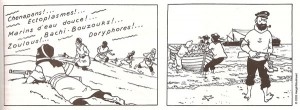Two Panels by Herge


He's fully satisfied with these.
Hergé: …I am quite happy with the panel showing the panic in the ranks of the pillagers [above left]. It’s one of the two panels that satisfy me fully: in a single panel, a series of movements, broken down and distributed among several characters. It could have been the same individual, lying down first, then getting up slowly, hesitating and finally running away. It’s basically, if you will, a shortcut through space and time.
Sadoul: What is the other drawing you’re happy with?
Hergé: It’s in Red Rackham’s Treasure [above right]. Everything is condensed, too, but in a different way. By looking at the drawing itself, which shows the captain walking barefoot on the beach while his companions are pushing the dinghy ashore, the spectator/reader mentally reconstructs what happened before: the “Sirius” has dropped anchor, a dinghy was lowered in the water, Tintin and his companions boarded; they rowed and finally reached the island where the captain just set foot. All this, which preceded the action depicted in the drawing, is expressed within that same panel. This drawing is based on a principle different from Crab’s – which I just described – where the effect is the result of both the simultaneity and the succession of movement. In this one, on the contrary, this is an unconscious reconstruction, by the reader, of movements which happened prior to the drawing. It’s like a self-generated mental flashback. Although the reader doesn’t realize it, he/she is unconsciously subjected to this entire analysis.
Sadoul, Numa. “The Hergé Interview.” The Comics Journal 250 (Feb 2003): 201.